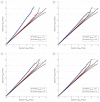Correcting systematic inflation in genetic association tests that consider interaction effects: application to a genome-wide association study of posttraumatic stress disorder
- PMID: 25354142
- PMCID: PMC4293022
- DOI: 10.1001/jamapsychiatry.2014.1339
Correcting systematic inflation in genetic association tests that consider interaction effects: application to a genome-wide association study of posttraumatic stress disorder
Abstract
Importance: Genetic association studies of psychiatric outcomes often consider interactions with environmental exposures and, in particular, apply tests that jointly consider gene and gene-environment interaction effects for analysis. Using a genome-wide association study (GWAS) of posttraumatic stress disorder (PTSD), we report that heteroscedasticity (defined as variability in outcome that differs by the value of the environmental exposure) can invalidate traditional joint tests of gene and gene-environment interaction.
Objectives: To identify the cause of bias in traditional joint tests of gene and gene-environment interaction in a PTSD GWAS and determine whether proposed robust joint tests are insensitive to this problem.
Design, setting, and participants: The PTSD GWAS data set consisted of 3359 individuals (978 men and 2381 women) from the Grady Trauma Project (GTP), a cohort study from Atlanta, Georgia. The GTP performed genome-wide genotyping of participants and collected environmental exposures using the Childhood Trauma Questionnaire and Trauma Experiences Inventory.
Main outcomes and measures: We performed joint interaction testing of the Beck Depression Inventory and modified PTSD Symptom Scale in the GTP GWAS. We assessed systematic bias in our interaction analyses using quantile-quantile plots and genome-wide inflation factors.
Results: Application of the traditional joint interaction test to the GTP GWAS yielded systematic inflation across different outcomes and environmental exposures (inflation-factor estimates ranging from 1.07 to 1.21), whereas application of the robust joint test to the same data set yielded no such inflation (inflation-factor estimates ranging from 1.01 to 1.02). Simulated data further revealed that the robust joint test is valid in different heteroscedasticity models, whereas the traditional joint test is invalid. The robust joint test also has power similar to the traditional joint test when heteroscedasticity is not an issue.
Conclusions and relevance: We believe the robust joint test should be used in candidate-gene studies and GWASs of psychiatric outcomes that consider environmental interactions. To make the procedure useful for applied investigators, we created a software tool that can be called from the popular PLINK package for analysis.
Figures




References
Publication types
MeSH terms
Grants and funding
LinkOut - more resources
Full Text Sources
Other Literature Sources
Medical

